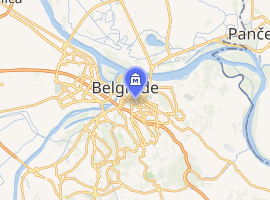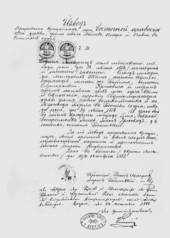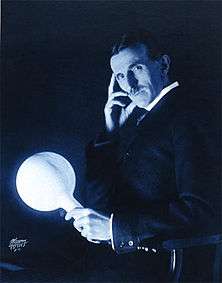Nikola Tesla Museum
The Nikola Tesla Museum (Serbian: Музеј Николе Тесле / Muzej Nikole Tesle) is a science museum located in the central area of Belgrade, the capital of Serbia. It is dedicated to honoring and displaying the life and work of Nikola Tesla as well as the final resting place for Tesla. It holds more than 160,000 original documents, over 2,000 books and journals, over 1,200 historical technical exhibits, over 1,500 photographs and photo plates of original, technical objects, instruments and apparatus, and over 1,000 plans and drawings.
View on Museum from street | |

| |
| Established | 5 December 1952 |
|---|---|
| Location | Krunska 51, Belgrade |
| Coordinates | 44.8051°N 20.4707°E |
| Type | Science museum |
| Visitors | 120,000 (2017)[1] |
| Director | Ivona Jevtić |
| Curator | Bratislav Stojiljković |
| Website | nikolateslamuseum |
The Nikola Tesla Archive was inscribed on UNESCO's Memory of the World Programme Register in 2003 due to its critical role regarding history of electrification of the world and future technological advancements in this area.[2]
History
The Nikola Tesla Museum is housed in a residential villa built in 1927 according to the designs of Dragiša Brašovan, a distinguished Serbian architect. The building was used for various purposes until December 5, 1952, when the Nikola Tesla Museum was founded in accordance with the decision of the Government of the Federal People's Republic of Yugoslavia. Certain items for the museum were shipped from New York City to Belgrade, Yugoslavia, on September 7, 1951, as a result of efforts by Sava Kosanović, Tesla's nephew and closest relative[3] and his attorney Philip Wittenberg.
Exhibitions
The permanent exhibition was arranged in 1955. From time to time there have been some modifications, but for many years the basic concept has remained the same. Its first part is primarily a memorial exhibition, while the second part is an interactive one, with 3D computer generated models of Tesla's inventions. From time to time, the museum organizes thematic exhibitions of documents, photographs and other material in order to display some periods from Tesla's inventive life.
Reconstruction
Reconstruction of the Nikola Tesla Museum started on November 3, 2006. The first phase of the project was scheduled to have been complete by the end of 2006. The garden on the roof of the museum was designed to be enclosed by glass windows, which would turn the roof into a computer room. This reconstruction is now complete, and the museum is available to visit.[4]
Gallery
 Baptismal record of Nikola Tesla, c. 24 July 1856.
Baptismal record of Nikola Tesla, c. 24 July 1856. A copy of the two phase induction motor from 1887. The original Tesla induction motor from 1887 is in Imperial College London.[5]
A copy of the two phase induction motor from 1887. The original Tesla induction motor from 1887 is in Imperial College London.[5] Cross-section of asynchronous motor built on Tesla's principles
Cross-section of asynchronous motor built on Tesla's principles Induction motor with an egg shaped rotor, popularly called the Egg of Columbus. This is a copy of the original shown at the World's Columbian Exposition in 1893
Induction motor with an egg shaped rotor, popularly called the Egg of Columbus. This is a copy of the original shown at the World's Columbian Exposition in 1893 Polyphase system. Showing an example of generation, transmission and utilization of electrical energy.
Polyphase system. Showing an example of generation, transmission and utilization of electrical energy.- Model of a boat operated by remote control
 Telecommand unit for model boat
Telecommand unit for model boat
 Tesla's urn
Tesla's urn Personal items
Personal items Bust of Tesla
Bust of Tesla Tesla's suit
Tesla's suit A demonstration being conducted for tourists
A demonstration being conducted for tourists
See also
- Nikola Tesla Memorial Center, museum in Smiljan, Croatia
- Nikola Tesla
- Wardenclyffe tower
- Wireless energy transmission
- Tesla Science Center at Wardenclyffe
References
- Tanjug (25 December 2017). "Muzej Nikole Tesle u 2017. posetilo 120.000 ljudi" [120.000 people visited Nikola Tesla Museum in 2017] (in Serbian). Radio Television Serbia.
- "Nikola Tesla's Archive". UNESCO Memory of the World Programme. 2008-05-16. Archived from the original on 2009-03-12. Retrieved 2009-12-10.
- KGB agent, codename "KOLO", see American Espionage and Project Venona
- "Archived copy". Archived from the original on 2013-09-28. Retrieved 2013-10-02.CS1 maint: archived copy as title (link)
- http://www.sciencemuseum.org.uk/objects/electricity_supply/1927-157.aspx
